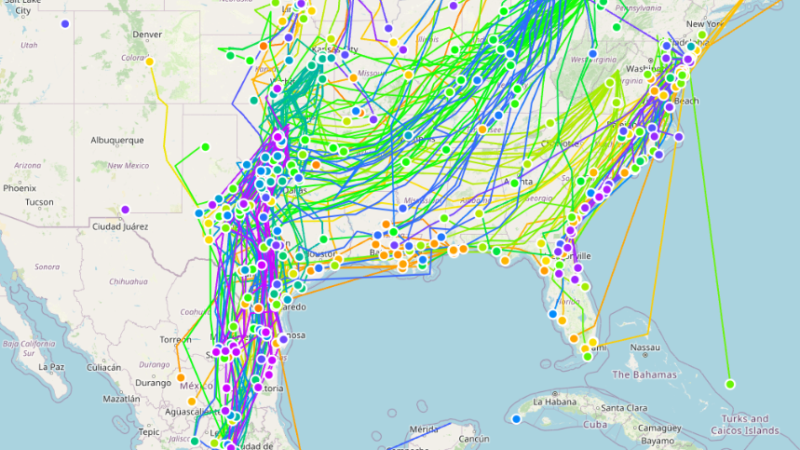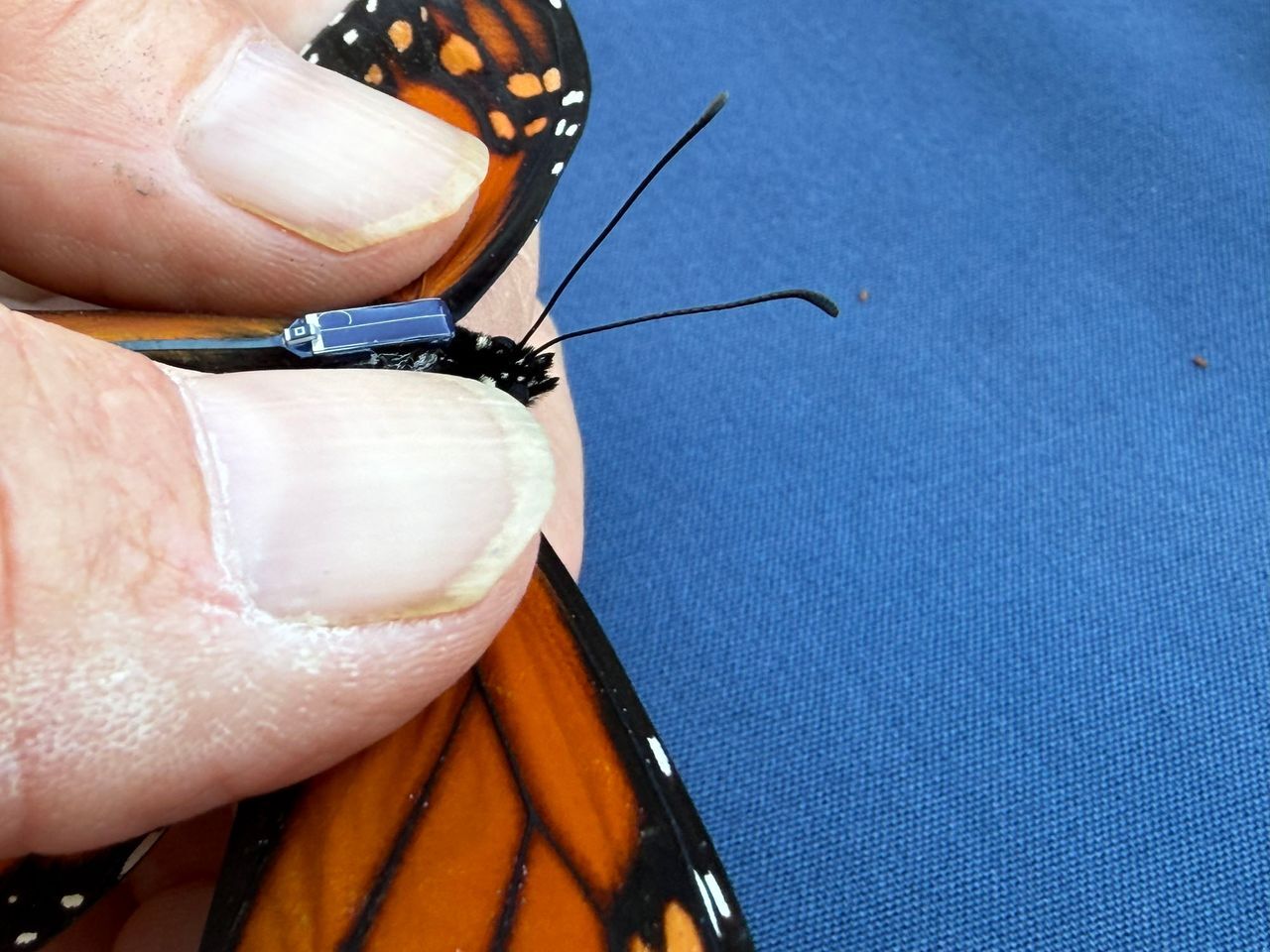
In the most comprehensive tracking study of monarch butterfly migration ever conducted, a collaboration of over 20 research and conservation organizations across four countries has successfully tracked individual monarchs over thousands of miles. The butterflies were followed from locations throughout North America and the Caribbean to their overwintering sites in Mexico using revolutionary ultralight transmitters and an innovative network that turns millions of everyday devices into wildlife tracking stations.
Project Monarch, a collaborative effort founded by Cellular Tracking Technologies (CTT) and the Cape May Point Arts & Science Center (CMPASC), united over 20 partner organizations, including the Monarch Joint Venture, to deploy over 400 BlūMorpho transmitters on migrating monarchs during fall 2025. The results have shattered previous limitations in butterfly tracking, providing scientists with high-resolution, near-real-time data on individual butterflies as they navigate their epic journey south.
From Moonshot to Reality
When CTT moved to Cape May, New Jersey, in 2015, naturalist Mark Garland from NJ Audubon's Monarch Monitoring Project posed a challenge: could they build a transmitter light enough for a monarch butterfly?
"At the time, it seemed nearly impossible," said Mike Lanzone, President and CEO at CTT. "Monarchs weigh less than a gram, and conventional tracking technology was simply too heavy."
CTT made it an audacious company goal to develop the first transmitter capable of tracking a monarch all the way to Mexico. By 2017, they had a proof-of-concept, but even at 0.15 grams, it was too heavy for sustained migration. The breakthrough came in 2021 when engineer Eric Johnson identified a new chipset, and CTT leveraged in-house advanced manufacturing techniques from custom solar panels the size of a grain of rice to surface mount technology that provided the ability to assemble the precision circuitry. The result: the 60-milligram BlūMorpho, a solar-powered transmitter operating at 2.4 GHz (Bluetooth frequency), allowing detection by both dedicated wildlife receivers and everyday smartphones.
Building the Network
In 2023, CMPASC funded the very first deployments of BlūMorpho transmitters and the development of the Project Monarch App, transforming smartphone users into receivers. Over 3,000 community scientists joined, creating detection networks across Cape May. The CMPASC continued to support the deployment of tags in 2024 as the Project Monarch collaboration was launched with the first handful of collaborator organizations. Combined with growing Motus Wildlife Tracking System stations and Terra mini base stations, coverage improved, but remained limited.
Everything changed in November 2024 when a butterfly named Lionel, equipped with a new additional bit of programming code, dubbed Blū+, was released in Cape May Point. By tapping into crowd-sourced location networks, Lionel provided the first high-resolution track of monarch migration ever recorded, with hundreds of detections to St. Augustine, Florida.
"Lionel’s track was a pivotal moment for us," said Dr. Sean Burcher, senior R&D scientist at CTT and science director at CMPASC. "With hundreds of millions of devices all acting as passive receivers, we were able to watch the fine-scale movements of Lionel in near-real-time."

Scaling to Continental Coverage
In September 2025, Environment and Climate Change Canada researchers Ana Diaz Bohorquez and Greg Mitchell, in collaboration with Birds Canada, deployed 30 Blū+ transmitters at Long Point, Ontario. Monarchs streamed southwest, crossing Lake Erie with stunning tracking data. These real-time observations complemented the work Dr. Leone Brown and her graduate student, at James Madison University, were doing to quantify the effects of tags on movement and behavior, and were consistent with their findings that survival was unlikely to be impacted in properly tagged individuals.
"Those 30 tags showed this was a game-changer," said Dr. David La Puma, director of global market development at CTT. "They provided an amazing visual of monarchs crossing Lake Erie and passing through urban and suburban Ohio. We realized that if we could have many deployments at many locations, we would really be able to see how monarchs move through the landscape and respond to weather; we knew that to make this a reality, we had to mobilize quickly."
By October 2025, dozens of researchers had joined the effort. Over 400 transmitters were deployed from Canada to Cuba. The collaboration provided free or reduced-cost transmitters, waived fees, and shared data through the Blū+ Portal and the Project Monarch app. Partners agreed to standardized protocols and collective publication crediting all contributors.

"This is a rising tide that lifts all boats," said La Puma. "By pooling resources and data, we've created something far greater than the sum of its parts."
Current Status
As of Nov. 9, tagged monarchs are entering the Monarch Butterfly Biosphere Reserve in Mexico. Mexican partners are searching for butterflies using the app and handheld receivers, while their smartphones serve as passive detectors. With proper permitting, partners hope to deploy transmitters on monarchs leaving Mexico in spring 2026, tracking their return journey north.

2025 Project Monarch Collaborating Organizations: Alas Mayas | Ambiomas | Banding Coalition of the Americas | Birds Canada / Oiseaux Canada - Long Point Bird Observatory and Motus Wildlife Tracking System | Cape May Bird Observatory | Cape May Point Arts and Sciences Center | Cellular Tracking Technologies | Environment and Climate Change Canada | Environment for the Americas | FOCEN (Fondo de Conservación del Eje Neovolcánico) | James Madison University | Latin Monarch | Monarch Joint Venture | Monarch Watch | National Commission of Protected Natural Areas (CONANP) | New Jersey Audubon | Norris Lab | Princeton University | Profauna México | Red comunitaria de aprendizaje en turismo alternativo | Southwest Monarch Study | University of Guelph | University of Miami | US Forest Service (Department of Agriculture) | World Wildlife Fund (WWF) Mexico | Xerces Society
About Cellular Tracking Technologies: Cellular Tracking Technologies (CTT) is a global wildlife telemetry leader based in Cape May, New Jersey. Founded in 2007 by scientists and engineers, CTT has pioneered tracking innovations, including the world's lightest transmitter, now deployed in over 50 countries. From Golden Eagles to monarch butterflies, CTT's technologies enable groundbreaking conservation research worldwide.
About Cape May Point Arts & Science Center: The Cape May Point Arts & Science Center is a nonprofit organization advancing conservation at the intersection of the Atlantic Ocean and Delaware Bay. Established in 2022 along the Atlantic Flyway, the Center is home to Project Monarch and funds groundbreaking research partnerships while providing educational programs that connect communities to science and nature.
Any media looking to interview the Monarch Joint Venture about this effort can email media@monarchjointventure.org.
